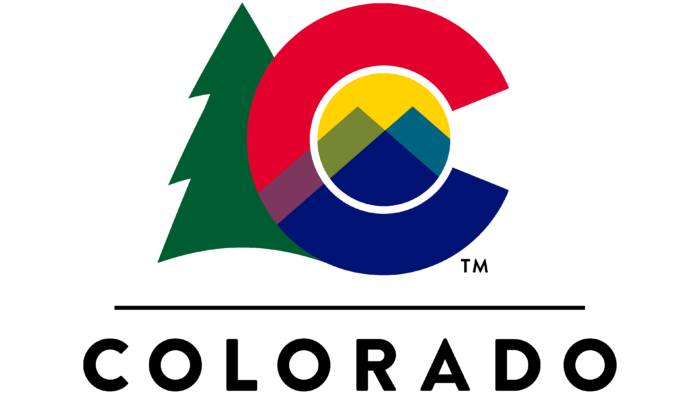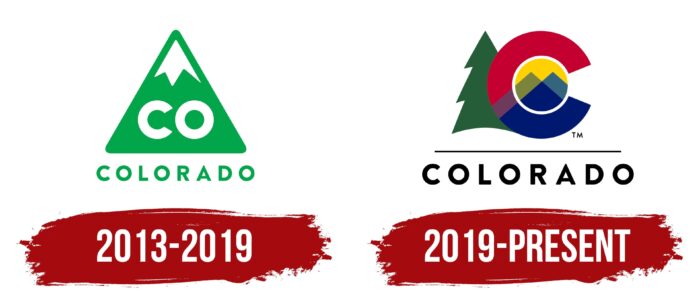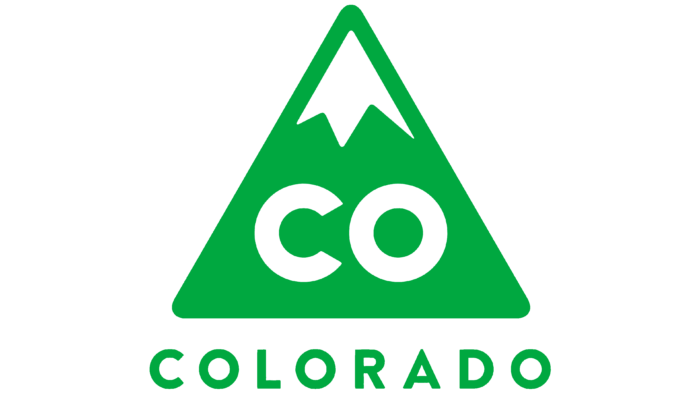The Colorado logo is unique and inimitable, just like the American state it represents. The breadth of the expanses, green massifs, and high mountains is reflected in its concept. At the same time, the emblem represents more than just the landscape – it symbolizes the region’s friendliness, cordiality, and uniqueness. This is well conveyed in the color palette and original elements.
Colorado: Brand overview
| Founded: | August 1, 1876 |
| Headquarters: | United States |
| Website: | colorado.gov |
The west-central United States is occupied by Colorado, a mountainous state surrounded by Wyoming and Nebraska, Oklahoma and Kansas, New Mexico, and Utah. Being 8 in the area – about 2,700 km2 the state has a local population of 5782171. The largest American metropolis today, Denver, became the state capital, which led to its rapid development. Colorado officially became the 38th state in 1876. That year America celebrated its centennial, which was the reason for its second unofficial name, “Centennial State.”
All state territorial units that make up the country have their symbols and seal. These distinctive signs and regalia recently added the official logo, which has undergone a radical change since its inception. For Colorado, it was created in 2013 to meet modern requirements, new digital technologies, and the use of the Internet at the state and municipal level.
Meaning and History
The development of the territory of the future state began back in the 16th century by Spanish conquistadors. In 1706, Spain declared it a colony. The river flowing through its territory also gave the name of this land – Colorado, which in translation from Spanish means red-brown. This is the color of the river during floods because of the silt, which fills all the coastal areas and provides this color to the water. Almost half a century later, the province became French, and in 1803 the United States bought the eastern part of it. The appetite of young America was, as now, quite good. And already in 1845, the U.S. seized its central part, and only three years later the western part, taking advantage of successes in the Mexican War.
The struggle for this territory was not accidental. Local diggers were constantly bringing word of the gold available here. In the 1850s, a rich gold mine was discovered near the state capital, sparking a “gold rush.” But the success of the development was interrupted by the Civil War in 1861, which divided the gold prospectors into Confederates and Unionists, who outnumbered them. Confederate General Sibley, in 1862 undertook a campaign to seize Colorado and its mines. He was opposed by Northern volunteers commanded by Colonel Slough, who gave the Confederates a general battle on March 26 at Glorieta Pass.
The years 1863-1865 were bloody because of the violent military confrontation between whites and the native population- the Arapaho, Cheyenne, Sioux, Cayowa, and Comanche Indians. It ended in the total defeat of the latter, leading to their relocation to reservations.
After ten years, to formalize its rights to this territory, the U.S. Congress developed a formal legislative act which formed the conditions necessary to be fulfilled for joining the United States as a new state. And within a year, Colorado became the 38th star on the star-spangled banner.
The region grew rapidly. The 1930 census showed population growth, with more than a million people over the line, a continuing influx of immigrants, and a significant increase in the birth rate. The Great Depression did not spare it, leading to great losses in various areas, including the region’s economy. But the end of the Second World War allowed directing all the resources to the recovery of the territory, making the main branches of the state – mining, agriculture, and tourism, the development of which continues today.
The interesting point is that this state was the first to pass a law that provided for the legalization of the narcotic substance marijuana.
After the war in the middle of the last century, the changes in society and the world demonstrated the need to increase investment in the service sector. By this time, the role of mining in the region had significantly diminished. Today, the state successfully develops mechanical engineering and metallurgy, chemical, and food industries. Despite a wide variety of mineral deposits, most of them are already depleted. But its role in mining and supplying oil, uranium, vanadium, and molybdenum is still high. Today, the state is famous for its unique and tasty beer, taking the lead among U.S. producers.
All of this is reflected in the region’s state, municipal, and image marks. Following the development of technology and the desire to improve and stimulate the development of the tourism area, which is particularly effective today in the interactive digital zone, through the Internet and television, the regional leadership decided to develop a state logo. The designers had to think and create an emblem that would fully and qualitatively reflect the characteristics of the state, would be attractive and consistent with the requirements of modern technology, visually easy to perceive by network users.
2013 – 2019
The first logo was created using elements that characterized the state itself and were done in one color. In the logo’s background was an isosceles triangle symbolizing the Rocky Mountain peak, the top of which is under the snow cover that runs through Colorado. The triangle is made using a fill of a shade of lettuce. This color was chosen because of the large number of coniferous forests in the state, which symbolized this characteristic of the region. The snow-covered top was created by leaving a blank space of paint, reminiscent of the snow scene on the tops of the mountains from a distance. A blank area is left in the center of the triangle, which forms two uppercase letters, “C” and “O” – the initial letters of the state’s name. At the bottom, as a proportional continuation of the triangle’s base, the state’s full name is written in capital letters. The text is in the color of the triangle filling.
2019 – today
As time passed, six years after creating the first logo, it was decided to make it more attractive and immediately recognizable so that you can understand the essence and affiliation at the first cursory glance. This is due to today’s younger generation’s peculiarities of the fragmentary perception of information. The first emblem required a more attentive attitude, obligatory reading of the inscription at the bottom to get an idea of what kind of sign it was. The last logo provided this understanding instantly while attracting the eye and easily remembered due to the bright multicolor execution.
Colorado: Interesting Facts
Colorado is a state full of natural wonders and exciting history.
- High Altitude: Colorado is the state with the highest elevation on average in the USA. Even its lowest point is over 3,317 feet high. This means lots of beautiful mountains.
- Four Corners Monument: This is a spot where Colorado meets Arizona, New Mexico, and Utah. You can stand in four states at once here.
- Denver’s Elevation: Denver, the state capital, is one mile above sea level, which is why it’s called the “Mile High City.”
- Marijuana Legalization: In 2012, Colorado was one of the first states to allow marijuana for fun. This has brought a lot of money to the state and inspired other places to do the same.
- Air Force Academy: The United States Air Force Academy is in Colorado Springs. It’s a top military and academic institution with a beautiful campus.
- Biggest Hot Springs Pool: In Glenwood Springs, you can find the world’s largest mineral springs pool. It’s huge, stretching over two blocks.
- Outdoor Fun: Colorado is a paradise for outdoor lovers. You can go skiing, snowboarding, mountain biking, and hiking. Places like Vail and Aspen are famous worldwide.
- Colfax Avenue: This street in Denver is the longest continuous commercial street in the U.S. It’s filled with history, fun spots, and nightlife.
- Rocky Mountain National Park is a must-visit for nature lovers. It offers stunning views, wildlife, and over 300 miles of trails.
- Bent’s Old Fort: This fur trading post offers a glimpse into the 1840s and shows what life was like on the frontier.
Colorado is a pretty place. It’s full of history, adventure, and landmarks that tell stories of the past and present. Whether you love exploring the outdoors, learning about history, or enjoying city life, Colorado has something for you.
Font and Colors
The new logo was made using a variety of bright colors from the color palette. The central element was the symbol of the state from its flag – the letter “C,” which is the initial letter of its name. The font and proportions of the letter are fully consistent with the original. Two-thirds of the “C” from the top is filled in red, the color used on the state symbols. The remainder is in dark blue, which is fully consistent with the color of the two stripes of the flag. The inner part of the letter sign on the flag is occupied by a gold circle, symbolizing the presence of gold mines. It is repeated in the logo with strict compliance with the filling shade. But its lower segment from the edge of the circle and just above the middle is occupied by a stylized image of two mountain peaks overlapping each other. One peak is green; the other is blue. Their intersection produces a triangle in the color of the flag’s stripes, symbolizing the all-seeing eye of God. Everything is done so harmoniously that the left and right borders of the dark blue at the bottom of the “C” are like a natural continuation of the sides of the triangle, formed by the intersection of the two mountain peaks of the central element.
In the background, to the left of the symbol, stands stylized green spruce, the top of which is at the same level as the top of the letter. A small part of the tree is hidden behind the curve of the “C.” To the right of the letter is the TM sign.
Beneath this composition is a thin black line separating the image from the text. The text, the state’s name, is in black capital letters. It completes the entire composition, ensuring its visual perception’s unity and harmony.
Colorado color codes
| Khaki Green | Hex color: | #768632 |
|---|---|---|
| RGB: | 118 134 50 | |
| CMYK: | 12 0 63 47 | |
| Pantone: | PMS 7496 C |
| Cadmium Green | Hex color: | #005d32 |
|---|---|---|
| RGB: | 0 93 50 | |
| CMYK: | 100 0 46 64 | |
| Pantone: | PMS 3415 C |
| Medium Candy Apple Red | Hex color: | #e4002c |
|---|---|---|
| RGB: | 228 0 44 | |
| CMYK: | 0 100 81 11 | |
| Pantone: | PMS Bright Red C |
| Yellow | Hex color: | #ffd200 |
|---|---|---|
| RGB: | 255 210 0 | |
| CMYK: | 0 18 100 0 | |
| Pantone: | PMS 109 C |
| Sea Blue | Hex color: | #006480 |
|---|---|---|
| RGB: | 0 100 128 | |
| CMYK: | 100 22 0 50 | |
| Pantone: | PMS 634 C |
| Boysenberry | Hex color: | #7c375e |
|---|---|---|
| RGB: | 124 55 94 | |
| CMYK: | 0 56 24 51 | |
| Pantone: | PMS 689 C |
| Midnight Blue | Hex color: | #001273 |
|---|---|---|
| RGB: | 0 18 115 | |
| CMYK: | 100 84 0 55 | |
| Pantone: | PMS 2745 C |
| Black | Hex color: | #000000 |
|---|---|---|
| RGB: | 0 0 0 | |
| CMYK: | 0 0 0 100 | |
| Pantone: | PMS Process Black C |








